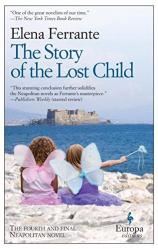The Story of the Lost Child: The Fourth and Final Neapolitan Novel
Review
The Story of the Lost Child: The Fourth and Final Neapolitan Novel
It is difficult to think of any contemporary novel that matches Elena Ferrante’s epic bildungsroman in terms of scope. The complete series, which runs now to well over 1,500 pages, is reminiscent of the vast novel of the 19th century, the “sea of words” in Bellow’s memorable phrase, in which entire lives play themselves out before us. Reading THE STORY OF THE LOST CHILD, one encounters details from the previous books, events and characters from decades earlier in the narrative that you have all but forgotten, and the memory of them stirs dimly in your recollection, like episodes from your own life that lie dormant until they are brought up nostalgically over drinks with an old friend or an old lover. It is an uncanny feeling.
If discussions of Elena Ferrante that do not touch upon the mystery of her identity happen anywhere, I have not heard them. The obsession with her identity makes me think of something I was once told by a croupier. There are two types of high rollers. The first likes to have lots of people in the room to witness him throwing his money around, well-dressed strangers to cheer on cue, and to soak up the complimentary drinks. The second likes to be alone with the dealer, no spectators, sliding their chips across the table in silence. “But even with the second type of guy” the croupier said, “they like people outside to know they’re in there by themselves.” A similar irony attends to Ferrante’s anonymity. Her refusal to come out of the shadows has meant that theories of who the author behind these extraordinary books might be (woman or man? individual or group?) have taken on more rather than less prominence in relation to how the books are understood.
"Reading THE STORY OF THE LOST CHILD, one encounters details from the previous books, events and characters from decades earlier in the narrative that you have all but forgotten, and the memory of them stirs dimly in your recollection, like episodes from your own life that lie dormant until they are brought up nostalgically over drinks with an old friend or an old lover."
As the series has unfolded, it has become clear that the question of what relation an author ought to have to a book is not just a context for the novels, but also one of its major themes. Lila, as we know from the prologue to MY BRILLIANT FRIEND, the first book, is going to disappear at the end of the story. It is this act that inspires Elena to write her memoirs in the first place, to try somehow to bring her vanished friend back into the light. Lila does not simply want to go missing, but also to erase every trace of herself, as though she never existed at all. This desire, as Lila explicitly tells Elena, is the very opposite of signing your name to a book. “To write,” she says, “you have to want something to survive you. […]If I could eliminate myself now, while we’re speaking, I would.”
To Elena, however, authorship is not so much about posterity as about improving her lot in the here and now. She persists with the idea that by achieving fame through her writing, she can lift herself and her friends out of the oppressive lives into which they were born. When she learns that a work of feminist fiction she wrote in Italian has been translated and published in France without her knowledge, she reflects: “That little volume was like a rock that I had hurled along an unpredictable trajectory and at a speed that had no comparison with that of the rocks that as girls Lila and I had thrown at the gangs of boys.” You don’t throw a rock so that someone in the distant future will pick it up and say, “The person who threw this must have been very important.” You throw it to draw blood, to break bones.
But fiction is far from unequivocally beneficial to Elena. Like so many novels about novelists, Ferrante’s masterpiece becomes a meditation on Yeats’ old dilemma, that “The intellect of man [and woman!] is forced to choose perfection of the life or of the work,” but with a specifically feminist slant. Elena’s mother-in-law rewords Yeats as such: “A woman separated, with two children, and your ambitions, has to take account of reality and decide what she can give up and what she can’t.” Elena’s writing eats into the time that she is able to put into bringing up her children, it loses her friends, and it brings shame to her family. Ultimately, it makes her some very powerful enemies.
Between Lila’s total self-effacement and Elena’s desire to gain power through her reputation lies a middle path, one trodden by the two women’s creator. By publishing anonymously, Ferrante manages (symbolically if not literally) to separate the life entirely from the work. She is at once someone who does not exist --- Elena Ferrante is simply a name on the spines, words without a physical referent --- and someone who has the power of an audience, someone to whom people listen, even if she has to put on a mask before she speaks.
Reviewed by Frederick Lloyd on September 8, 2015
The Story of the Lost Child: The Fourth and Final Neapolitan Novel
- Publication Date: September 1, 2015
- Genres: Fiction
- Paperback: 480 pages
- Publisher: Europa Editions
- ISBN-10: 1609452860
- ISBN-13: 9781609452865





